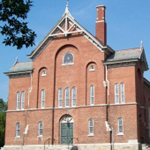 |
Lima Presbyterian Church |
 |
||||
|
The small village church at the main crossroads in Lima |
||||||
| Worship & Music | Faith Development | Congregational Life | Mission Outreach | Please Join Us | ||
| ||||||||||||||||||
|
Sermon 3-6-11
"What to Do With the Transfiguration?" The sermon title actually gives it away. I’m not sure of the meaning of the Matthew and 2 Peter passages about the transfiguration. Many have looked at this illumination of Christ and many have been left uncertain. Now it is possible that that is in fact the point – to present a mystery for us to ponder during Lent. We’ll be fellow travelers during Lent, so let me tell you what I have found. The transfiguration event is described in Matthew, Mark and Luke in remarkably similar language. Clearly, therefore, this was thought to be something to pay attention to carefully. The fact that the transfiguration took place on a high mountain where many propitious biblical events occurred supports this significance. For example, it has direct parallels with Moses’ experiences on Mt. Sinai. The transfiguration, we may conclude, is definitely an important milestone in Jesus’ life. Still, there are some interesting curiosities. In Matthew verse 3, Elijah and Moses are seen with Jesus. How did the disciples recognize them? Both had been dead for hundreds of years. Anyhow, since they were recognized, Moses is thought to represent the Law, the first five books of the Bible - Genesis Exodus, Leviticus, Numbers and Deuteronomy. Elijah is thought to represent the Prophets - Isaiah, Jeremiah, Lamentations, Ezekiel and Daniel. By verse 8 Elijah and Moses have disappeared. Probably this is meant to confirm Jesus both as their successor and the fulfillment of the law and the Prophets. Moving along in Matthew verse 5 we read: While he was still speaking, suddenly a bright cloud overshadowed them, and from the cloud a voice said, “This is my Son, the Beloved; with him I am well pleased; listen to him!” This scene is repeated almost verbatim in Mark and Luke. “This is my son, the Beloved” sounds as if Jesus is being presented to the disciples. Not only are these words similar across the gospels, they are also nearly identical to the words from heaven at Jesus’ baptism in three gospels. I see Jesus’ baptism as the official beginning of his ministry and his transfiguration as a kind of public commissioning to carry that ministry through to the end, which was already in sight. There are parallels for Presbyterians in the wording used in our own baptisms and ordinations as elders and deacons. For those of you who don’t remember the exact words used in your baptisms and ordinations, let me assure you that they are similar. In both services we are claimed as God’s own, God’s beloved. While the words spoken by God are similar in Jesus’ baptism and in his transfiguration, here in the transfiguration, the words, “Listen to Him” have been added. “Listen to him” is not about Jesus. Rather, it is God speaking to us. The full sense of “listen” includes “pay attention” and “obey.” God is telling the disciples, and us, that we have a lot to learn, that what is to come in the next 40 days is going to be both wonderful and painful, a life like no others’, and it will transform us too. Stay tuned, in other words. 2nd Peter (1:19) is real clear about this: So we have the prophetic message more fully confirmed. You will do well to be attentive to this as to a lamp shining in a dark place, until the day dawns and the morning star rises in your hearts. But back to Matthew verse 6,
When the disciples heard this, Hearing God speak to them from a cloud does have the effect of knocking people off their feet. Here prostration may also show devotion. Or perhaps it was actual fear if the disciples were remembering the warning in Exodus (20:19). There the Israelites told Moses:
You speak to us, and we will listen; God does speak to us in big and overwhelming events in our lives – illnesses, deaths, aging and accidents. God also speaks to us in the hundreds of little joys and surprises we experience every day in offices, supermarkets, and families. God even speaks to us in stillness and silence and prayer. Perhaps it is not so much the speaking itself, but the content of what God is saying that bothers us – the message that we are to die to the pettiness that our humanness drags us into and instead live into the greatness that God envisions for us. Jesus reassured the disciples and us, “Get up and do not be afraid.” This is only the death of your small selves, Jesus is telling the disciples, there is really nothing to fear from that. Another curiosity: on their way down the mountain Jesus tells the disciples,
Tell no one about the vision until after the
Son of Man The Greek word for “vision” attributed to Jesus here at the conclusion of the transfiguration story is most often used to describe a supernatural or psychic vision rather than an actual physical event. Did this mountain top experience happen or was it a dream? Vision or not, in our 2nd Peter reading the apostle Peter describes his presence on the mountain as if it were a physical event. Or is the significance of this event not so much about what happened to Jesus as about what happened to the vision of the disciples? Were they the ones transfigured? By extension, then, is it about our eyes being opened? And we still have to wonder why the disciples were to tell no one. Second Peter (1:20) may have the answer:
First of all, you must understand this, Can you imagine the fear that this passage strikes into the hearts of preachers who are trying to make sense of all this? That’s why this sermon title is really a question, “What to do about the transfiguration?” Subsequent events showed that Jesus was right to warn the disciples “tell no one” because they really didn’t understand what was going on and wouldn’t until the resurrection. Yet we see that understanding really wasn’t the key. The disciples continued to follow Jesus, to the crucifixion and beyond. That was what they had to do. Listen and follow could be our metaphor for the Lenten season, which begins on Wednesday. In Lent, we are to pray, fast, look inward, and ask for forgiveness for our pettiness. Note that this is not at all the same as seeking understanding. Instead, it is seeking openness; it is being ready to hear when God says “listen.” It may be challenging holding ourselves open, dwelling in this mystery. In one of The Chronicles of Narnia books by C.S.Lewis, the children, Eustace and Jill, are about to return to their home world. Aslan, the lion, who is a Christ figure, warns them: Here on the mountain I have spoken to you clearly. I will not often do so down in Narnia. Here on the mountain, the air is clear and your mind is clear; as you drop down into Narnia, the air will thicken. Take great care that it does not confuse your mind. And the signs, which you have learned here, will not look at all as you expect them to look, when you meet them there. That is why it is so important to know them by heart and pay no attention to appearance. Remember the signs and believe the signs. Nothing else matters. God has prepared us for the illuminating, the transfiguring moments in our lives, here in the world below the mountain. Let us not imagine that we understand the magnificence of God, but instead be ready to listen to God. We may be surprised to find that God is whispering to us every day. In following those whispers we are in Peter’s words (1:21) “men and women moved by the Holy Spirit.” Maybe we’ll even “get it” by Easter, just as the disciples did. Thanks be to God. Amen. |
| |||||||||